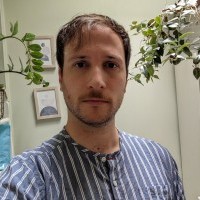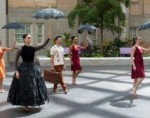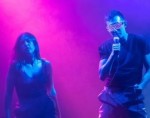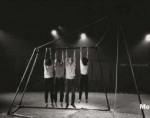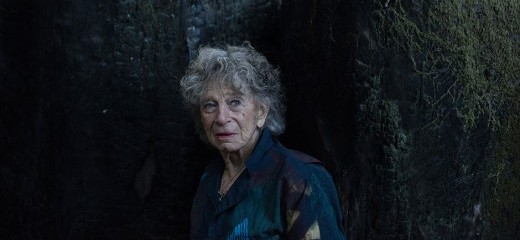
Allies, icons, and inter-generational collaboration
by Andrew Sargus Klein
Sculptor and performance artist Janine Antoni's career retrospective at Philadelphia’s Fabric Workshop and Museum in 2016 was called Ally. (Coverage on thINKingDANCE included an interview with curator Adrian Heathfield, a review from Carolyn Merritt, and a review by Jonathan Stein.) Ally is also the title for the book-length collection of essays, photographs, and collages that serves as the monograph for its namesake.
Ally the text is a difficult object. It’s occasionally convoluted, unsure of what it wants do with its subjects, and employs some unwieldy graphic design. But, most importantly, it succeeds at its core goal: revealing Ally the event as a tremendous, even groundbreaking accomplishment.
Instead of a typical curation of past works for her retrospective, Antoni collaborated with choreographer Stephen Petronio and iconic movement artist Anna Halprin. The three created a series of performances and installations that combined and reinterpreted individual works from their respective pasts through an incredible and far-reaching creative process of humility and generosity. The overall aesthetic is deeply feminist, with themes such as birth and renewal, maternity and lineage, body image and gaze.
This intergenerational exchange among such influential artists further subverts the expectation of a linear retrospective, and if you finished the book thinking it an in-depth homage to Halprin, you wouldn't be alone. She graces the cover, after all, in a striking image set in the woods, her gaze sliding over your right shoulder and her eyes set in a sort of contemplation. Just inside the cover is a full-spread photo of the outdoor performance space that Halprin’s husband, renowned landscape architect Lawrence Halprin, built for her on the coast of Northern California.
Halprin’s works, particularly her classic Parades and Changes, are often the primary catalysts for reinvention through collaboration. A lot of page real estate is used to follow the development of Paper Dance, Antoni’s take on Parades and Changes, and this documentation makes for the most striking imagery in the book. As Antoni, dancing solo with a long length of brown paper, wraps and entwines herself, the paper wrinkles and folds. Some of her gestures freeze into sculpture, until she gathers the paper around her and the objects are remade again.
The opening essay by editor Adrian Heathfield is a difficult journey. It first presents itself as a lyric essay. The speaker is both chronicler and participant, as if in an attempt to avoid the flatness of academic writing, but that approach is quickly dropped, and the subsequent prose folds in on itself in ever more dense layers. There is an unresolved tension in the need to present a scholarly framework for the book while allowing a more lyrical exploration coming from within the art itself. Stick with it, though, and you find that Heathfield is able to deliver a treasure trove of historical and aesthetic context to the work at hand. There are many important, overlapping, and nonlinear forces and movements at play in Ally, and Heathfield’s deep respect for the artists and their craft is clear.
Jacquelynn Baas’s essay is solely about Halprin, and it too has issues with how it treats its subject. After an extended and strange comparison of Halprin’s art to Hindu iconography, Baas claims that Halprin’s work “has been most strongly influenced by Native American ritual myth,” but doesn’t include support for such a claim despite the extensive use of footnotes in the essay. It’s a small moment, perhaps, but indicative of a problem found throughout Ally, which is that these texts get in their own way.
The same issues arise in the book as object. The book’s dimensions (nearly 10 in x 10 in) are built for photographs, but an enormous amount of space is given over to text, and a number of gorgeous photos are stuck in the corners of pages. The clean and bright interplay of white backgrounds, black text, and lush color photography are broken up by collages of photos and text and handwritten notes and diagrams. Several suffer from a severe lack of readability, others are just clumsy.
But, again, the art shines through, particularly in how Swallow is presented. The piece is a duet by Antoni and Petronio; they each swallow one end of a piece of a cloth in a Yogic ritual. They perform this act in a private home with a small audience. Only one photo is taken of the event. The book collects the verbal testimony of several audience members and presents them one after another. Just as photos can only go so far in communicating to the viewer the essence of movement art, verbal description is similarly rich, but limited. Reading the dozen or so individual accounts of the performance is a beautiful and simple tool to further the ephemerality of the ritual in particular and the experience and translation of art in general.
The cloth used from the performance of Swallow was presented in a clear box as part of an installation at the museum, along with moth larvae. The piece of fabric was slowly consumed as part of the moths’ gestational transformation. Along with the audience’s descriptions, there’s only one photo from the performance, but the effect is such that the past work feels present, and is as simple as it is striking. It’s one of several breathtaking moments in the retrospective.
The last text in the book, a short piece of experimental writing by Hélène Cixous titled “Simples / The Warbling of a Thrush” (translated from the French by Laurent Milesi), is presented without context. It’s a first-person narrative in the form of journal entries, and if you’re able to work your way into its interior logic — grammatically, syntactically, and aesthetically far removed from the rest of the book’s texts — a deeply moving experience unfolds.
A woman is taking care of her mother, who is suffering from an advanced form of dementia. The journal entries record action, sensation, and perception all at once in dizzyingly fluid prose. The complex braiding of the text is as unsettling as it is effective at delivering the reality of such a situation. There is no clear indication that this work is memoir, but the mother refers to the daughter as Hélène, and a sense of loss, love, and helplessness resonates so deep as to demand it be real, regardless.
There are unavoidable — and deliberate — connections between this text and the rest of the book. Some of these connections are straightforward: mother and daughter, caretaking, identity, and memory. But some of these connections are troubling. Halprin is in her 90s; death (or worse, (if you consider losing your selfhood to dementia to be worse than death), is not far away. Ally is largely successful in showing how Halprin’s foundational work lives on in younger artists (who will in turn pass that work forward), and how the forces that accompany artistic exploration and discovery are not linear and hold a certain intangible life of their own.
Such a detailed narrative of a woman losing her memory, her sense of self, until all but the briefest and faintest threads of familial recognition are gone, is devastating on its own — but when cast in the shadow of the texts that precede it in Ally, a parallel sadness pools. The mother mistakes the daughter for her own mother, and that moment resonates in both worlds: the world of art and ideas passing cyclically through generations, and the world where we might be forced to watch a loved one lose all sense of us. At the end of the text, the daughter helps transition her mother into what I assume is a full-time care facility, and we’re left with this exchange (the bracketed phrase is from the translator):
What makes you afraid? Where shall I place the fear-driver [chasse-peur]? Maman’s mind crumples an old smile: ‘I’m not afraid’.
I wasn’t ready for this ending. (I’m still not.) “Simples / The Warbling of a Thrush” is an incredible piece of writing (and an example of écriture féminine), and I applaud its inclusion while also wondering exactly how it’s meant to serve the entire work.
Ultimately, the book is incredibly generous in what it offers to its readers. It’s a crossroads for deep expanses of history, theory, and aesthetics, and well worth your time and effort. Sometimes a hard journey makes the end worthwhile, and with Ally, it doesn’t so much end as it leaves the door wide open.
Ally: Janine Antoni, Anna Halprin, Stephen Petronio, edited by Adrian Heathfield, 2018, The Fabric Workshop and Museum in conjunction with Hirmer Publishers. 224 pages.
By Andrew Sargus Klein
April 24, 2018

